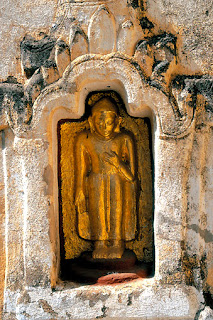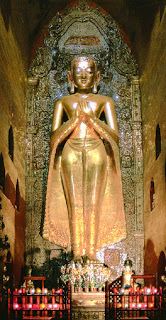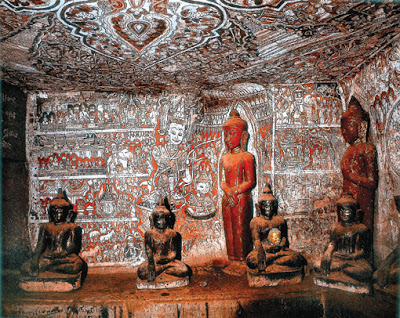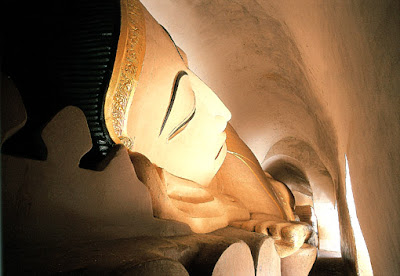Artists work everywhere.Fascinating Buddha statues and sculptures are plenty, actually there are countless of them in various conditions, many are still looking good but there are still enough which haven't seen any renovation yet. But since there are so many it's difficult to keep track and the money the tourists brings are often disappearing somewhere. There are big ones and small ones, decorated with gold leaves and of different colors. Some are of a high artistic level others quite simple. Often there have been a lot of thinking about by the artists who created them hundreds of years ago, e.g. how and were to place the object to bring the best impression some are placed to give spectacular shadow according to the sun position. Other dominate a temple interior or are just small figurines placed as pure decoration. |
|
There are not many art objects placed outside.
They are always in the shelter of a temple or a annex to a pagoda.

The designs of Buddha images.
On the murals they are very similar to the statues and during the entire historical development of the visual arts the iconography of Buddha sculptures made in various materials are always observed.
In certain periods natural proportions of local people morphed into the picture such as the large round and flat head, straight eyebrows and narrow, almost a horizontal line forming lips and a cap-like hairstyle.
This was more visible in Myanmar compared to Thailand and other neighboring countries. In most cases freestanding sculptures had the face and the hands painted and the vestment also painted or gilded. Lips were red, hair, eyebrows and eyes black.

 Overall, the faces of many sculptures began to morph into the type of ethnic Burmese which was of earlier time.
Overall, the faces of many sculptures began to morph into the type of ethnic Burmese which was of earlier time. Such a transformation of Buddhist iconography can be also recognized at some Buddha representations on the Shwedagon Pagoda Platform.
A group of iconography.
The stone Buddha images starting from the 12th to the 13th century have obvious similarities with the reproductions of Nats which are visible hardly by chance and testifies once more the influence of local traditions to the imprinted by the canons.
In the “Hey Days” of the Empire the Buddha representations were widespread with elegant proportions. The hands have long expressive fingers. Characteristic of some statues of this type are elongated face with curved raised eyebrows and a long nose and sensuous lips.
Examples for this type of Buddha are the ones in the Ananda Temple and the sculpture of many other Bagan’s older temple such as the Nagayon, the Abeyadona and other. In the same direction are votive tablets and steles from the 11th to 13th century. With regard to their iconographic characteristic neither Indian nor other neighboring countries show analogies.
Around the 17th century Buddha sculptures design lost quality, now they came with coarse heads and wide oval faces. The figures got long earlobes that extend to the broad shoulders and a characteristic smile was shown.
These Buddha figures are usually represented in various mudras.
It is interesting to note that those sculptures are mainly made in brick and stucco with often colorful painting including hair, eyes, lips, fingernails and an orange clothing.












No comments:
Post a Comment